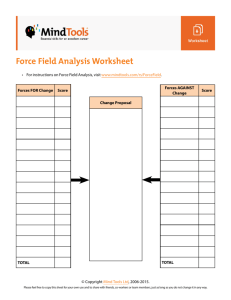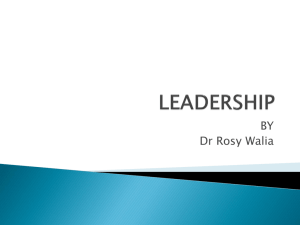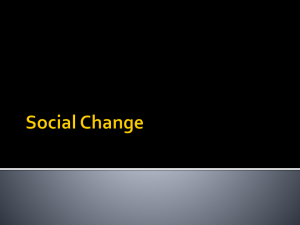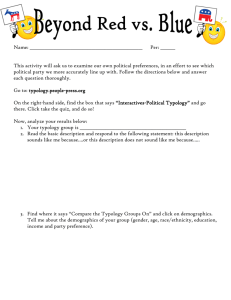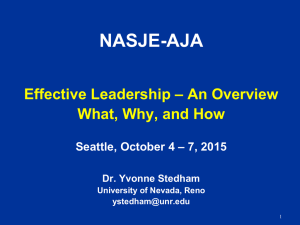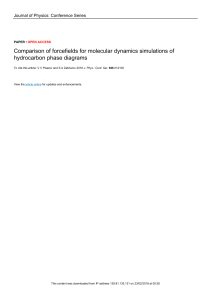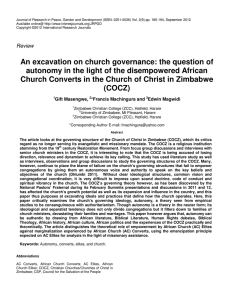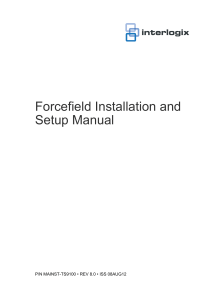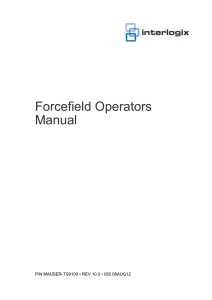Scientific management
advertisement
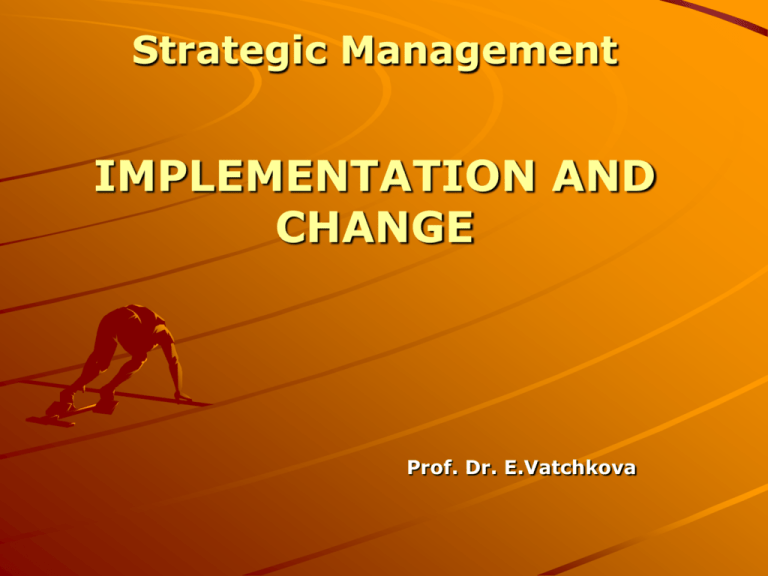
Strategic Management IMPLEMENTATION AND CHANGE Prof. Dr. E.Vatchkova CONTENTS 1. 2. 3. 4. 5. 6. 7. 8. 9. Understanding change Factors, causing change Typology Contextual features of change The process of strategic change Forcefield analysis Overcoming resistance to change Change strategies and tactics Communicating change 1. Understanding change Constant process “Status” of contemporary organization Main competitive advantage Means for long-term survival Managerial competence and competency 2. Factors, causing change External triggers: – – – – – – – technology customer’s tastes Competitor’s activities Materials Legislation Social or cultural values Economic circumstances Internal triggers to change Job design Product design Office and factory layouts Allocation of responsibilities Technology Typology Individual, group, organizational Innovative, adaptive, radical Reactive, proactive Technological, administrative, people Wanted, compulsory By stages, divisible, trial, reversible, non-reversible Concrete, known, relevant, attractive A Generic Typology of Organizational Change Adaptive Change “Reintroducing a familiar practice” Innovative Change “Introducing a practice new to the organization” Radically Innovative Change “Introducing a practice new to the industry” l Types of strategic change SCOPE Transformation Evolution Realignment Adaptation Incremental NATURE Big Bang Revolution Reconstrac tion Contextual features Time Scope Preservation Diversity Capability Capacity Readiness Power Steps in the change process Levin-Schein model: 1.unfreezing, 2.changing, 3.refreezing Richard Daft model: 1. 2. 3. 4. 5. 6. Need Idea Proposal Decision to adopt Implementation Resources FRAMEWORK FOR MANAGING STRATEGIC CHANGE Diagnosing the change situation Types of strategic change The importance of context Organizational culture Forcefield Analysis Management styles and roles Change agency roles: • Strategic leaders • Middle managers • Outsiders Styles of managing change Levers for managing change Structure & Control Routines Symbolic processes Political processes Communication Change tactics Force field analysis Identifying forces for and against change 1. What aspects of the current culture might aid change? 2. What aspects of the current culture would block such change? 3. What is to be introduced or developed to aid change? Forcefield analysis PUSHING High-quality service Ethos of hard work Flexibility Devolved services RESISTING Workload/overload Firefighting Departmentalism Departmental barons Formality of management Stories of “the good old days” Blame culture Deference Political mechanisms in organization ACTIVITY AREAS RESOURCES ELITES SUBSISTEMS SYMBOLIC KEY PROBLEMS Building Control Sponsors the power Acquisition hip of / base Association with elites Alliance building Team building Building on legitimation Time Dualty of ideas Existing elites OvercoWithdrawal ming resistance Use of “counterintelligence” Breakdown or devision Association with: change agent, Respected outsider Foster Attack or Striking momentum remove le- from too for change Gitimation low a Foster power Sponsorconfuson, ship/ base Conflict reward of Need for and ques- rapid change agent tionning rebuilding Achieving Compliance Implement Removal ation and of resistant elites collabo- Giving resources ration Applause/r Converting eward the body of Reassuran the organisation Change strategies Education and communication Collaboration/participation Invention Direction Coercion/edict STYLES OF MANAGING STRATEGIC CHANGE I Style Means /Context Education & Communication Group briefings assume internalization of strategic logic & trust of top management Collaboration Involvement in / Participation setting the strategy agenda &/or resolving strategic issues by taskforces or groups Benefits Problems Overcoming lack of (or miss) information Time consuming Direction or progress may be unclear Increasing ownership of a decision / process May improve quality of decisions Time consulting Solutions / outcomes within existing paradigm Circumstances of effectiveness Incremental change or long-time horizontal transformational change STYLES OF MANAGING STRATEGIC CHANGE II Style Means / Context Benefits Problems Circumstance s of effectiveness Intervention Change agent retains coordination/cont rol: delegates elements of change Process controlled but involvement takes place Risk of perceived manipulation Incremental/noncrisis transformational change Direction Use of authority to set direction & means of change Clarity & speed Risk of lack of acceptance & ill-conceived strategy Transformational change Coercion/edi ct Explicit use of power through edict Successful in crisis or state of confusion Least successful unless crisis Crisis, rapid transformational change or change in autocratic cultures Communication of change 1. Face to face (one-to-one or group) 2. Interactive (e.g. telephone, video, conferencing) 3. Personal “memoing” (e.g. tailored memos, letters) 4. General bulletins (e.g. circulars, announcement on notice boards) Effectiveness of communication Routine Complex Overly rich communication Causes confusion Rich communication for complex change EFFECTIVE COMMUNICATION Routine communication for Routine change Too little information and sensitivity leads to mistrust and lack of commitment TRENDS CREATING CHANGE in the ………….. Industry Write your ideas for how each trend impacts the ….. Industries and challenges human resource managements Trends Technology: Regulations: Economy: Business: Markets and Customers Competitions: Family and Social issues Impact on …………… Industry Challenges for Human Resource Management THANK YOU !
